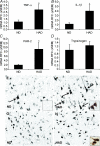The emergence of proteinase-activated receptor-2 as a novel target for the treatment of inflammation-related CNS disorders
- PMID: 17347265
- PMCID: PMC2075212
- DOI: 10.1113/jphysiol.2007.129577
The emergence of proteinase-activated receptor-2 as a novel target for the treatment of inflammation-related CNS disorders
Abstract
The signalling molecules that are involved in inflammatory pathways are now thought to play a part in many disorders of the central nervous system (CNS). In common with peripheral chronic inflammatory diseases such a rheumatoid arthritis and ulcerative colitis, evidence now exists for the involvement of inflammatory cytokines, for example tumour necrosis factor (TNF) and interleukins (IL), in neurological disorders. A common factor observed with the up-regulation of these cytokines in peripheral inflammatory diseases, is the increased expression of the proteinase-activated receptor (PAR) subtype PAR-2. Indeed, recent evidence suggests that targeting PAR-2 helps reduce joint swelling observed in animal models of arthritis. So could targeting this receptor prove to be useful in treating those CNS disorders where inflammatory processes are thought to play an intrinsic role? The aim of this review is to summarize the emerging data regarding the role of PAR-2 in neuroinflammation and ischaemic injury and discuss its potential as an exciting new target for the prevention and/or treatment of CNS disorders.
Figures



References
-
- Abayomi OK. Pathogenesis of cognitive decline following therapeutic irradiation for head and neck tumors. Acta Oncológica. 2002;41:346–351. - PubMed
-
- al-Ani B, Saifeddine M, Hollenberg MD. Detection of functional receptors for the proteinase-activated-receptor-2-activating polypeptide, SLIGRL-NH2, in rat vascular and gastric smooth muscle. Can J Physiol Pharmacol. 1995;73:1203–1207. - PubMed
-
- Amadesi S, Nie J, Vergnolle N, Cottrell GS, Grady EF, Trevisani M, Manni C, Geppetti P, McRoberts JA, Ennes H, Davis JB, Mayer EA, Bunnett NW. Protease-activated receptor 2 sensitizes the capsaicin receptor transient receptor potential vanilloid receptor 1 to induce hyperalgesia. J Neuroscience. 2004;24:4300–4312. - PMC - PubMed
-
- Asokananthan N, Graham PT, Fink J, Knight DA, Bakker AJ, McWilliam AS, Thompson PJ, Stewart GA. Activation of protease-activated receptor (PAR)-1, PAR-2, and PAR-4 stimulates IL-6, IL-8, and prostaglandin E2 release from human respiratory epithelial cells. J Immunol. 2002;168:3577–3585. - PubMed
Publication types
MeSH terms
Substances
LinkOut - more resources
Full Text Sources
Other Literature Sources

